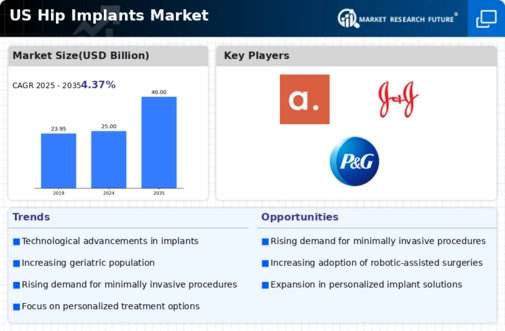The hip implants market is characterized by a competitive landscape that is both dynamic and multifaceted. Key growth drivers include an aging population, increasing prevalence of hip-related disorders, and advancements in implant technology. Major players such as Johnson & Johnson (US), Stryker Corporation (US), and Zimmer Biomet (US) are strategically positioned to leverage these trends. Johnson & Johnson (US) focuses on innovation through its DePuy Synthes division, emphasizing the development of next-generation implants. Stryker Corporation (US) has adopted a strategy centered on digital transformation, integrating advanced technologies into its product offerings. Zimmer Biomet (US) is pursuing regional expansion, particularly in emerging markets, to enhance its market share. Collectively, these strategies contribute to a competitive environment that is increasingly defined by technological advancements and market responsiveness.
Key business tactics within the hip implants market include localizing manufacturing and optimizing supply chains to enhance efficiency and reduce costs. The market structure appears moderately fragmented, with several key players holding substantial market shares. This fragmentation allows for a diverse range of products and innovations, while the collective influence of these major companies shapes market dynamics and competitive strategies.
In October 2025, Stryker Corporation (US) announced the launch of its new robotic-assisted surgical system, which is designed to enhance precision in hip implant procedures. This strategic move underscores Stryker's commitment to integrating cutting-edge technology into its offerings, potentially improving surgical outcomes and patient satisfaction. The introduction of this system may also position Stryker as a leader in the growing trend of robotic-assisted surgeries, thereby enhancing its competitive edge.
In September 2025, Zimmer Biomet (US) expanded its partnership with a leading telehealth provider to enhance remote patient monitoring capabilities for hip implant recipients. This collaboration aims to improve patient engagement and post-operative care, reflecting a broader trend towards digital health solutions in the medical device sector. By investing in telehealth, Zimmer Biomet (US) not only addresses patient needs but also strengthens its market position in an increasingly digital healthcare landscape.
In August 2025, Johnson & Johnson (US) unveiled a new line of biodegradable hip implants, which are designed to reduce environmental impact while maintaining performance standards. This initiative aligns with the growing emphasis on sustainability within the medical device industry. By prioritizing eco-friendly solutions, Johnson & Johnson (US) may attract environmentally conscious consumers and healthcare providers, thereby differentiating itself in a competitive market.
As of November 2025, current competitive trends in the hip implants market include a pronounced focus on digitalization, sustainability, and the integration of artificial intelligence (AI) into product development. Strategic alliances are increasingly shaping the landscape, enabling companies to pool resources and expertise to drive innovation. Looking ahead, competitive differentiation is likely to evolve from traditional price-based competition towards a focus on technological innovation, supply chain reliability, and sustainable practices. This shift may redefine market dynamics, compelling companies to adapt and innovate continuously to maintain their competitive positions.

















Leave a Comment